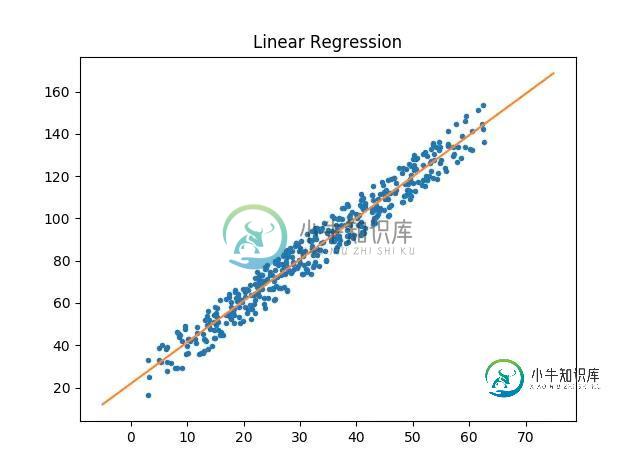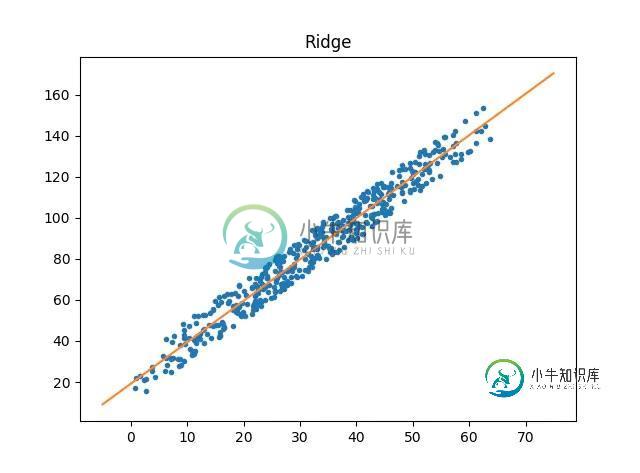Python 实现3种回归模型(Linear Regression,Lasso,Ridge)的示例
公共的抽象基类
import numpy as np
from abc import ABCMeta, abstractmethod
class LinearModel(metaclass=ABCMeta):
"""
Abstract base class of Linear Model.
"""
def __init__(self):
# Before fit or predict, please transform samples' mean to 0, var to 1.
self.scaler = StandardScaler()
@abstractmethod
def fit(self, X, y):
"""fit func"""
def predict(self, X):
# before predict, you must run fit func.
if not hasattr(self, 'coef_'):
raise Exception('Please run `fit` before predict')
X = self.scaler.transform(X)
X = np.c_[np.ones(X.shape[0]), X]
# `x @ y` == `np.dot(x, y)`
return X @ self.coef_
Linear Regression
class LinearRegression(LinearModel): """ Linear Regression. """ def __init__(self): super().__init__() def fit(self, X, y): """ :param X_: shape = (n_samples + 1, n_features) :param y: shape = (n_samples]) :return: self """ self.scaler.fit(X) X = self.scaler.transform(X) X = np.c_[np.ones(X.shape[0]), X] self.coef_ = np.linalg.inv(X.T @ X) @ X.T @ y return self
Lasso
class Lasso(LinearModel):
"""
Lasso Regression, training by Coordinate Descent.
cost = ||X @ coef_||^2 + alpha * ||coef_||_1
"""
def __init__(self, alpha=1.0, n_iter=1000, e=0.1):
self.alpha = alpha
self.n_iter = n_iter
self.e = e
super().__init__()
def fit(self, X, y):
self.scaler.fit(X)
X = self.scaler.transform(X)
X = np.c_[np.ones(X.shape[0]), X]
self.coef_ = np.zeros(X.shape[1])
for _ in range(self.n_iter):
z = np.sum(X * X, axis=0)
tmp = np.zeros(X.shape[1])
for k in range(X.shape[1]):
wk = self.coef_[k]
self.coef_[k] = 0
p_k = X[:, k] @ (y - X @ self.coef_)
if p_k < -self.alpha / 2:
w_k = (p_k + self.alpha / 2) / z[k]
elif p_k > self.alpha / 2:
w_k = (p_k - self.alpha / 2) / z[k]
else:
w_k = 0
tmp[k] = w_k
self.coef_[k] = wk
if np.linalg.norm(self.coef_ - tmp) < self.e:
break
self.coef_ = tmp
return self
Ridge
class Ridge(LinearModel): """ Ridge Regression. """ def __init__(self, alpha=1.0): self.alpha = alpha super().__init__() def fit(self, X, y): """ :param X_: shape = (n_samples + 1, n_features) :param y: shape = (n_samples]) :return: self """ self.scaler.fit(X) X = self.scaler.transform(X) X = np.c_[np.ones(X.shape[0]), X] self.coef_ = np.linalg.inv( X.T @ X + self.alpha * np.eye(X.shape[1])) @ X.T @ y return self
测试代码
import matplotlib.pyplot as plt
import numpy as np
def gen_reg_data():
X = np.arange(0, 45, 0.1)
X = X + np.random.random(size=X.shape[0]) * 20
y = 2 * X + np.random.random(size=X.shape[0]) * 20 + 10
return X, y
def test_linear_regression():
clf = LinearRegression()
X, y = gen_reg_data()
clf.fit(X, y)
plt.plot(X, y, '.')
X_axis = np.arange(-5, 75, 0.1)
plt.plot(X_axis, clf.predict(X_axis))
plt.title("Linear Regression")
plt.show()
def test_lasso():
clf = Lasso()
X, y = gen_reg_data()
clf.fit(X, y)
plt.plot(X, y, '.')
X_axis = np.arange(-5, 75, 0.1)
plt.plot(X_axis, clf.predict(X_axis))
plt.title("Lasso")
plt.show()
def test_ridge():
clf = Ridge()
X, y = gen_reg_data()
clf.fit(X, y)
plt.plot(X, y, '.')
X_axis = np.arange(-5, 75, 0.1)
plt.plot(X_axis, clf.predict(X_axis))
plt.title("Ridge")
plt.show()
测试效果



更多机器学习代码,请访问 https://github.com/WiseDoge/plume
以上就是Python 实现 3 种回归模型(Linear Regression,Lasso,Ridge)的示例的详细内容,更多关于Python 实现 回归模型的资料请关注小牛知识库其它相关文章!
-
本文向大家介绍python实现逻辑回归的示例,包括了python实现逻辑回归的示例的使用技巧和注意事项,需要的朋友参考一下 代码 以上就是python实现逻辑回归的示例的详细内容,更多关于python 逻辑回归的资料请关注呐喊教程其它相关文章!
-
本文向大家介绍带你学习Python如何实现回归树模型,包括了带你学习Python如何实现回归树模型的使用技巧和注意事项,需要的朋友参考一下 所谓的回归树模型其实就是用树形模型来解决回归问题,树模型当中最经典的自然还是决策树模型,它也是几乎所有树模型的基础。虽然基本结构都是使用决策树,但是根据预测方法的不同也可以分为两种。第一种,树上的叶子节点就对应一个预测值和分类树对应,这一种方法称为回归树。第二
-
Logistic回归模型 二项Logistic回归模型(binomial logistic regression model)是一种分类模型,由条件概率分布$$P(Y|X)$$表示,形式为参数化的logistic分布。 一、模型定义 模型是如下的条件概率分布: $$ P(Y=1|X)=\dfrac{e{w\cdot x+b}}{1+e{w\cdot x+b}} $$ $$ P(Y=0|X)=1-P
-
本文向大家介绍Python基于numpy模块实现回归预测,包括了Python基于numpy模块实现回归预测的使用技巧和注意事项,需要的朋友参考一下 代码如下 上面的一段代码利用numpy生成数据序列,并实现了1阶回归,并画出预测效果图,图形如下: 将代码改一下,实现2阶、3阶回归预测,只需要model = np.polyfit(t, y, deg =2)即可,同理3阶模型就把deg改为3即可。 2
-
线性回归模型(linear regression) 1.模型定义 给定数据集,$$T={(x{(1)},y{(1)}),(x{(2)},y{(2)}),...,(x{(m)},y{(m)})}$$,其中$$x{(i)}=(1, x_1, x_2, ..., x_n)T\in X= R{n+1}$$,$$y{(i)}\in Y=R$$,线性回归模型试图学到一个通过属性的线性组合来进行预测的函数,即
-
本文向大家介绍Python实现的线性回归算法示例【附csv文件下载】,包括了Python实现的线性回归算法示例【附csv文件下载】的使用技巧和注意事项,需要的朋友参考一下 本文实例讲述了Python实现的线性回归算法。分享给大家供大家参考,具体如下: 用python实现线性回归 Using Python to Implement Line Regression Algorithm 小菜鸟记录学习过

